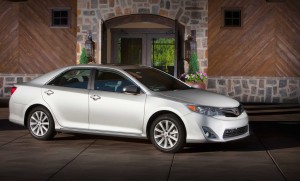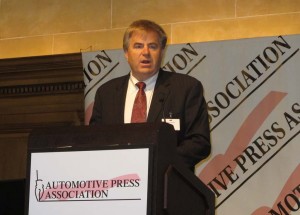August’s strong automotive sales surge seems to have taken everyone by surprise, including top managers at Toyota — demand for the Japanese maker’s Toyota, Lexus and Scion branded products jumping nearly 23% last month as the U.S. market reached its highest level in at least six years.
A variety of factors seem to be drawing buyers back to showrooms, suggested Bob Carter, senior vice president of automotive operations for Toyota Motor Sales, USA. But one stands out, “Consumer confidence,” he said succinctly. “People are feeling good,” and are increasingly willing to open up their pocketbooks again.
Industry analysts and observers have been steadily raising their forecasts for 2013 and beyond, and Toyota is no exception. After the worst industry downturn in decades, demand is likely to top 15.5 million this year, and could nudge into 16 million territory in 2014. But how high is up? Speaking to the Detroit Automotive Press Association, Carter noted some forecasters anticipate near-record numbers of 17 million by as early as 2018.
“That’s not our view,” cautioned the Toyota veteran, though something well above 16 million seems certain. The other question is how sustainable the current numbers are? Carter said he is betting that auto sales will grow at a much slower pace than this year’s torrid, double-digit rate, and will likely float in the 15 million to 16 million area for much of the rest of the decade, adding that this would be, “really healthy for the industry.”
(Toyota, Japanese makers lead August sales boom. Click Herefor more.)
Admitting that as a “car sales guy,” his genetic make-up is tuned to ever-growing sales, Carter said that’s not always the best situation. Major swings up in demand can be nearly as troubling as sharp drops, forcing makers to either add capacity or give up market share.
That’s not to say that even in a relatively flat environment things would be easy. The U.S. market is going through some major shifts, some products such as minivans, are losing momentum while others – notably compact crossovers – are booming. That will force makers to shift production capacity or lose sales, the Toyota executive emphasized.
One reason Carter may be comfortable with slower growth in the U.S. market is that Toyota itself continues to gain a growing share. It has surged to the second spot, passing Ford Motor Co. for the past two months and breathing down the neck of General Motors, especially if one focuses on retail, rather than lower-profit fleet, sales.
In August, Toyota had four of the 10 best-selling vehicles in the U.S., including the midsize Camry which nudged past the Chevrolet Silverado to become the number two model.
(Camry one of August’s big winners. Click Here to find out who the other winners — and losers — were.)
Toyota did have to give the Camry a nudge to overcome aggressive challenges from the likes of the fifth-ranked Honda Accord, the eighth-ranked Nissan Altima and the Ford Fusion. That meant a big bump in incentives which came to $2,480 a vehicle on Camry, according to estimates from J.D. Power and Associates.
That number is high for Toyota “by historical averages,” Carter acknowledged, though he insisted it was not out of line with “where the competition is.”
In all, Toyota had four of August’s best-sellers. But increased incentives aren’t the maker’s only challenge. Toyota’s youth-oriented Scion division has lost much of its momentum emerging from the Great Recession, and Carter cautioned it will take time to build it back up.
“We know that under-30 buyers got hit hardest by the recession,” he pointed out.” And while Toyota remains “absolutely committed” to rebuilding the brand with fresh product, that will be “further out” than the flood of new offerings coming for the Toyota and Lexus brands.
Carter pointed to the nine new offerings the various Toyota marques are launching this year, and it hopes to draw even bigger crowds to showrooms as it rolls out another two dozen over the next 24 months.
Assuming the market keeps growing, even at a slower pace, that could force Toyota to do some serious soul-searching about capacity limits. But the maker already appears to be preparing for that issue. It has invested $2.1 billion in North America over the last 22 months, and the $28 million it said Thursday that it will pump into its suburban Detroit powertrain R&D center suggests the spending spree is far from over.


